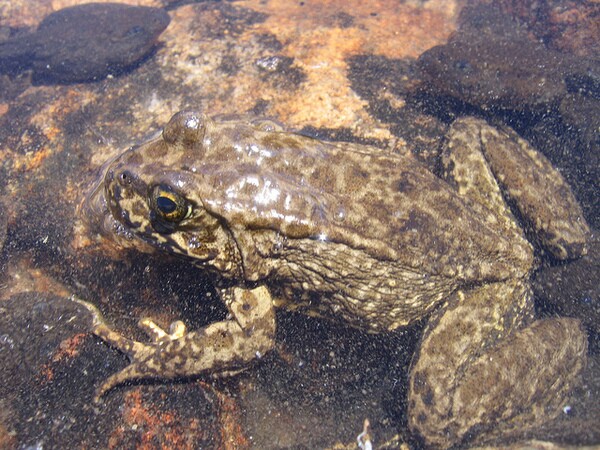Feds May Reopen Popular Climbing Spot in Frog Habitat

A popular climbing area in the Angeles National Forest may be reopened under strict management to protect the local population of an Endangered frog, the U.S. Forest Service announced Wednesday.
Williamson Rock, once one of Southern California's premier rock cliimbing destinations in the San Gabriel Mountains, was closed by the Forest Service in 2006 to protect federally Endangered mountain yellow-legged frogs in nearby streams, as well as peregrine falcons that nested in the immense granite outcrop.
In a public notice published Wednesday in the Federal Register, the Forest Service announced that it's seeking public comment on a plan to reopen the rock while keeping climbers from using the frog's stream bed habitat as approach routes.
First listed as Endangered in 2002, the Southern California population of the mountain yellow-legged frog (Rana muscosa) is a small, variably colored frog (in the orange-yellow-brown end of the spectrum) that reaches adult lengths between one and three inches. The mountain yellow-legged is in trouble throughout its range from all the usual sources: chyrtid fungus, pesticides, increased UV radiation, and pressure from introduced predators such as planted trout.
Mountain yellow-legged tadpoles require streams that don't dry up for at least two years in a row in order to make it to adulthood. Even after metamorphosing from tadpole to adult frogs, they rarely venture far from open water. That makes protecting their habitat in the increasingly droughty mountains of Southern California crucial for the survival of the species. Im the San Gabriel Mountains, the frogs seem to prefer rocky streams in canyon bottoms, which is pretty much the case where Little Rock Creek flows past the base of Williamson Rock.
The closure, which began as a result of lawsuits to protect the frog brought by the Center for Biological Diversity and other groups, has long been unpopular with climbers, and recreational groups such as the Access Fund and Friends of Williamson Rock, who have worked with agency officials to craft a plan to reopen the area.
A 2009 plan that would have done just that was postponed in the wake of the Station Fire, which torched a significant amount of nearby habitat for the frog, though the immediate vicinity of the rock was unburned.
Forest Service officials restarted the process of considering granting climber access to the rock last year. The agency had originally planned a less-stringent Environmental Assessment of a draft climber access plan, but decided that some of the potential environmental issues from the plan were serious enough to merit the full federal Environmental Impact Statement process, which forces more careful consideration of a project's effects on the environment.
In Wednesday's announcement, the Forest Service said that it will be seeking prelimnary public comments -- the "scoping" process mandated under the National Environmental Policy Act -- on a new access plan that includes closing at least two popular climbing areas at Williamson Rock; London Wall and Stream Wall. A decades-old network of informal trails that follow the streambed would be closed permanently as well. The rest of the rock would be open to climbing from August 1 through November 15, and USFS would build bridges over Little Rock Creek where the nearby Pacific Crest Trail and Long Trail now ford it.
Access for climbers would require visitor use permits, which would be limited so that no more than 90 climbers could use the area at any one time.
Once scoping comments are collected from the public, the Forest Service will write a Draft Environmental Impact Statement by Spring 2015, with the final version expected about a year from now.
The process may be somewhat contentious. Climbers' groups are likely to push for more daily permits and a smaller closed area of the streambed, while wildlife protection groups are concerned that use of the area will harm the yellow-legged frog.
"This is a highly impacted species," said Ileene Anderson, a biologist with the Center for Biological Diversity. "Those closures and permits are going to be hard to enforce, and any development in the creekbed is going to further jeopardize the frog."